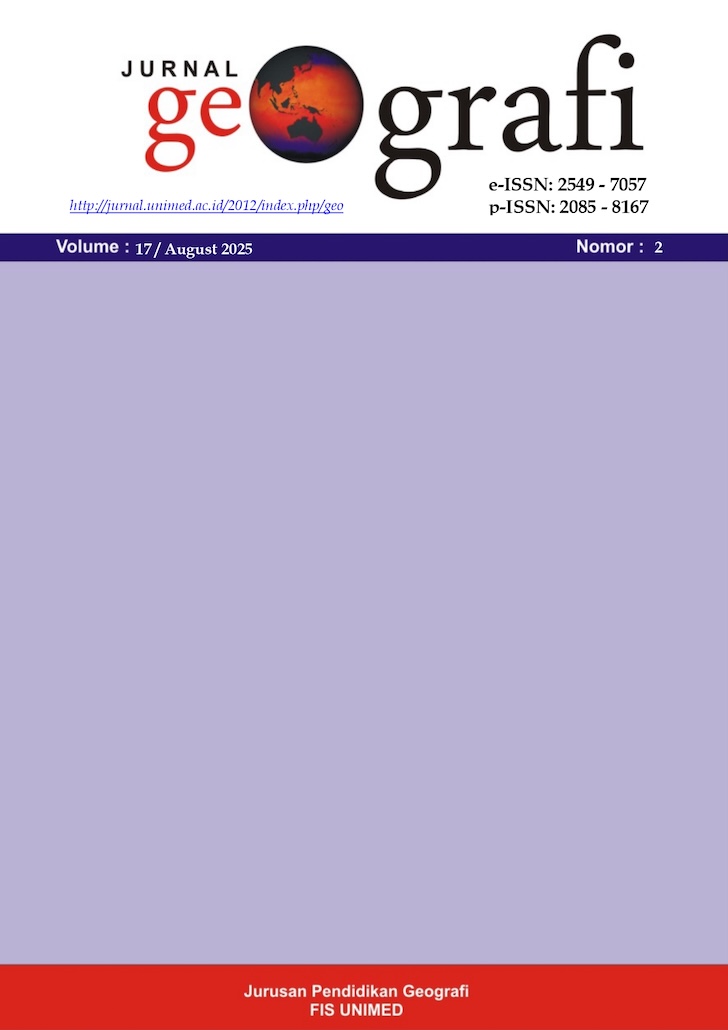Moderate Replacement Fertility: Tranquility Dimension Variables of Yogyakarta Special Region, Indonesia in 2023
DOI:
https://doi.org/10.24114/jg.v17i2.64617Keywords:
Tranquility, Fertility, YogyakartaAbstract
This study examines life tranquility in the context of moderate replacement fertility levels in the Special Region of Yogyakarta (DIY) in 2023. The region's diverse social, cultural, and economic characteristics significantly influence fertility trends and family dynamics. Areas like Sleman and Bantul display higher family proportions, reflecting stable fertility levels, while Yogyakarta City faces challenges in maintaining population growth due to lower fertility rates, influenced by urbanization and economic pressures. This urban-rural divide underscores the complex relationship between fertility patterns and socio-economic factors. Despite increasing birth rates in some areas, challenges persist in understanding fertility behaviors, particularly in relation to access to education, healthcare, and family policies. These factors can either support or hinder efforts to achieve sustainable population growth and well-being. This study explores the connections between moderate fertility rates, life tranquility, and socio-economic influences in DIY. It also examines how education, healthcare access, and family planning policies impact family well-being and fertility decisions. The research aims to provide policy solutions to enhance the quality of life for families across the region. By understanding the socio-economic determinants of fertility trends, this study offers insights into urban-rural differences and informs policy design to address fertility changes and promote stable family dynamics.References
Andersen, R. M. (1995). Revisiting the Behavioral Model and Access to Medical Care: Does it Matter? Journal of Health and Social Behavior, 36(1), 1. https://doi.org/10.2307/2137284
Arifin, E. N., & Ananta, A. (2016). Erratum: Chapter 20 The Past Three Population Censuses: A Deepening Ageing Population in Indonesia. In Contemporary Demographic Transformations in China, India and Indonesia (pp. E1–E1). Springer International Publishing. https://doi.org/10.1007/978-3-319-24783-0_23
Bongaarts, J., & Guilmoto, C. Z. (2015). How Many More Missing Women? Excess Female Mortality and Prenatal Sex Selection, 1970–2050. Population and Development Review, 41(2), 241–269. https://doi.org/10.1111/j.1728-4457.2015.00046.x
Bongaarts, J., & Hodgson, D. (2022). Socio-Economic Determinants of Fertility (pp. 51–62). https://doi.org/10.1007/978-3-031-11840-1_4
Bruce, S. (2011). Secularization Elsewhere. In Secularization (pp. 177–201). Oxford University Press. https://doi.org/10.1093/acprof:osobl/9780199654123.003.0009
Casterline, J. B., & Sinding, S. W. (2000). Unmet Need for Family Planning in Developing Countries and Implications for Population Policy. Population and Development Review, 26(4), 691–723. https://doi.org/10.1111/j.1728-4457.2000.00691.x
Chicoyo, C. (2016). Socio—Cultural Factors Influencing Fertility in MOROGORO District, Tanzania. IOSR Journal of Humanities and Social Science, 21(07), 25–41. https://doi.org/10.9790/0837-02107032541
Darki, N. W. Y. A., & Wibowo, A. (2023). Faktor yang Mempengaruhi Tingkat Fertilitas di Indonesia: Review Literatur. Media Gizi Kesmas, 12(1), 530–536. https://doi.org/10.20473/mgk.v12i1.2023.530-536
Duminy, J., Cleland, J., Harpham, T., Montgomery, M. R., Parnell, S., & Speizer, I. S. (2021). Urban Family Planning in Low- and Middle-Income Countries: A Critical Scoping Review. Frontiers in Global Women’s Health, 2. https://doi.org/10.3389/fgwh.2021.749636
Götmark, F., & Andersson, M. (2020). Human fertility in relation to education, economy, religion, contraception, and family planning programs. BMC Public Health, 20(1), 265. https://doi.org/10.1186/s12889-020-8331-7
Gough, I. (1996). Social assistance in Southern Europe. South European Society and Politics, 1(1), 1–23. https://doi.org/10.1080/13608749608454714
Hugo, G., Champion, A., & Lattes, A. (2003). Toward a New Conceptualization of Settlements for Demography. Population and Development Review, 29(2), 277–297. https://doi.org/10.1111/j.1728-4457.2003.00277.x
Johnston, R., Forrest, J., & Poulsen, M. (2002). Are there Ethnic Enclaves/Ghettos in English Cities? Urban Studies, 39(4), 591–618. https://doi.org/10.1080/00420980220119480
Jones, G. (2010). Changing Marriage Patterns in Asia. SSRN Electronic Journal. https://doi.org/10.2139/ssrn.1716533
Kulu, H., & Washbrook, E. (2014). Residential context, migration and fertility in a modern urban society. Advances in Life Course Research, 21, 168–182. https://doi.org/10.1016/j.alcr.2014.01.001
Lesthaeghe, R. (2014). The second demographic transition: A concise overview of its development. Proceedings of the National Academy of Sciences, 111(51), 18112–18115. https://doi.org/10.1073/pnas.1420441111
Marmot, M. (2005). Social determinants of health inequalities. The Lancet, 365(9464), 1099–1104. https://doi.org/10.1016/S0140-6736(05)71146-6
McQuillan, K. (2004). When Does Religion Influence Fertility? Population and Development Review, 30(1), 25–56. https://doi.org/10.1111/j.1728-4457.2004.00002.x
Mohd Ali, A. S., Junaini, S. N., Masron, T., Kimura, Y., & Ahmad, A. (2025). Urbanization and aging in ASEAN: A comparative demographic analysis from 1970 to 2023. Malaysian Journal of Society and Space, 21(2). https://doi.org/10.17576/geo-2025-2102-03
Oberle, M. (2016). Robert D. Putnam: Bowling Alone. The Collapse and Revival of American Community, New York: Simon and Schuster 2000, 541 S. In Klassiker der Sozialwissenschaften (pp. 408–411). Springer Fachmedien Wiesbaden. https://doi.org/10.1007/978-3-658-13213-2_95
Tan, K., Li, N. P., Meltzer, A. L., Chin, J. L. J., Tan, L. K. L., Lim, A. J., Neuberg, S. L., & van Vugt, M. (2022). Effects of economic uncertainty and socioeconomic status on reproductive timing: A life history approach. Current Research in Ecological and Social Psychology, 3, 100040. https://doi.org/10.1016/j.cresp.2022.100040
Downloads
Published
How to Cite
Issue
Section
License
Copyright (c) 2025 Seri Aryati, Sukamdi Sukamdi, Umi Listyaningsih

This work is licensed under a Creative Commons Attribution-ShareAlike 4.0 International License.







